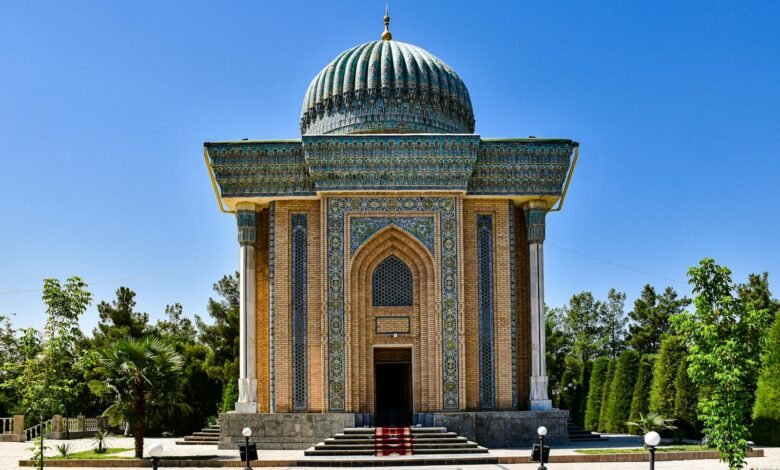
Introduction
Uzbekistan is a treasure trove of Islamic heritage, home to some of the most magnificent mosques (masajid) in the world. With its deep ties to the Silk Road and rich Islamic history, the country offers travelers a unique opportunity to witness stunning architecture, spiritual tranquility, and a glimpse into the enduring legacy of Islamic civilization. This guide highlights some of the most famous masajid in Uzbekistan and what makes each one special.
1. Bibi-Khanym Mosque, Samarkand
- Historical Significance: Built in the 15th century under the reign of Timur (Tamerlane), the Bibi-Khanym Mosque was once one of the largest and most magnificent mosques in the Islamic world.
- Key Features:
- Massive entrance portal with intricate mosaic work.
- A grand courtyard surrounded by domes and minarets.
- Stunning Quranic calligraphy and blue-tiled designs.
- Tip for Visitors: Visit early in the morning or late afternoon to enjoy the mosque’s beauty in soft light and avoid crowds.
2. Minor Mosque, Tashkent
- Historical Significance: A modern mosque built in 2014, showcasing contemporary Islamic architecture.
- Key Features:
- Pristine white marble exterior and a striking blue dome.
- Spacious interior with a peaceful ambiance.
- Located by the Ankhor River, offering scenic views.
- Tip for Visitors: Combine your visit with a walk along the river for a relaxing experience.
3. Kalon Mosque, Bukhara
- Historical Significance: Part of the iconic Poi Kalon complex, this mosque dates back to the 16th century and is a symbol of Bukhara’s rich Islamic heritage.
- Key Features:
- Massive courtyard surrounded by arcades.
- The iconic Kalon Minaret, a masterpiece of Islamic architecture.
- Capacity to hold over 10,000 worshippers.
- Tip for Visitors: Visit during sunset to see the Kalon Minaret beautifully lit up.
4. Hazrat Imam Complex, Tashkent
- Historical Significance: A significant Islamic center in Tashkent housing the Uthman Quran, considered one of the oldest copies of the Quran in the world.
- Key Features:
- Multiple masajid within the complex, including the Hazrat Imam Mosque.
- A library with ancient Islamic manuscripts.
- Beautifully landscaped gardens.
- Tip for Visitors: Allocate enough time to explore the entire complex and its cultural treasures.
5. Shah-i-Zinda Complex, Samarkand
- Historical Significance: A UNESCO World Heritage Site, Shah-i-Zinda (The Living King) is a necropolis with mosques and mausoleums dating back to the 11th century.
- Key Features:
- Unique tilework in vibrant blues and greens.
- Connection to Qusam ibn Abbas, a cousin of Prophet Muhammad (PBUH).
- Spiritual and historical significance.
- Tip for Visitors: Walk along the narrow corridors and explore each intricately decorated chamber.
6. Maghoki-Attar Mosque, Bukhara
- Historical Significance: Believed to be one of the oldest mosques in Central Asia, built in the 9th century.
- Key Features:
- Unique blend of Islamic and Zoroastrian architectural influences.
- Underground prayer hall with a tranquil atmosphere.
- Ancient carvings and brickwork.
- Tip for Visitors: Perfect for history buffs interested in early Islamic architecture.
7. Juma Mosque, Khiva
- Historical Significance: A unique mosque in Khiva with origins dating back to the 10th century.
- Key Features:
- 213 wooden pillars supporting the mosque’s roof, some dating back centuries.
- Simple yet striking interior design.
- Central skylights providing natural light and ventilation.
- Tip for Visitors: Appreciate the craftsmanship of the ancient wooden columns and the serene environment.
8. Imam Bukhari Mausoleum and Mosque, Samarkand
- Historical Significance: A sacred site dedicated to Imam Muhammad al-Bukhari, the compiler of Sahih al-Bukhari, one of the most authentic collections of Hadith.
- Key Features:
- Beautifully landscaped gardens surrounding the mosque and mausoleum.
- A serene prayer space and a museum showcasing Islamic artifacts.
- Tip for Visitors: Make this a spiritual pilgrimage and reflect on the contributions of Imam Bukhari to Islamic scholarship.
Practical Tips for Visiting Masajid in Uzbekistan
- Dress Modestly: Ensure your clothing covers your shoulders and knees. Women should bring a scarf to cover their heads.
- Prayer Spaces: While many mosques are open to tourists, prayer spaces are reserved for worshippers, so respect the sanctity of these areas.
- Timing: Avoid visiting during prayer times unless you are joining for Salah.
- Guided Tours: Many historical mosques offer guided tours to explain their history and significance.
- Photography: Ask for permission before taking photos, especially in prayer areas.
Conclusion
Uzbekistan’s masajid are not only places of worship but also living monuments to Islamic history, culture, and art. Whether you’re a practicing Muslim or a traveler with an interest in history and architecture, these masajid offer a chance to connect with Uzbekistan’s spiritual heritage and marvel at the beauty of Islamic design.



